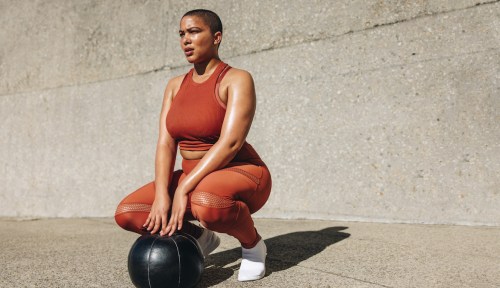HIIT vs. Boot Camp: Which One Gives You the Best Workout?
Ever wonder which modality is most effective when it comes to HIIT vs. bootcamp? Trainer, Charlee Atkins explains the difference.

The terms “HIIT” and “boot camp”— once reserved for the super-human athletes—have since seeped into the lexicon of mainstream fitness culture, where they’re used to describe two popular workout genres (the likes of which you’ll find at fitness studios across the country and on any YouTube-compatible screen). Both HIIT and boot camp incorporate bursts of intense, repetitive activity—often to the brink of muscle exhaustion—before moving on to the next exercise in a predetermined series.
Experts in This Article
fitness trainer and founder of Le Sweat
By virtue of elevating your heart rate and strengthening myriad muscles, both HIIT and boot camp boast similar, if not seemingly identical, benefits. Proponents for each workout abound; but how, exactly, does one differentiate between the two? More pressing, perhaps, is the question of which is more effective: boot camp or HIIT? Below, Charlee Atkins, CSCS, creator of Le Sweat TV, gives us the bottom line.
HIIT vs. boot camp: understanding the terminologies
If you’re unclear on the differences between HIIT and boot camp, it’s understandable. According to Atkins, “HIIT and boot camp are used interchangeably,” within the realm of group fitness classes and mainstream fitness culture. Moreover, she adds, they’re often employed as “marketing terms [rather] than actual science-based training methods.”
Mainstream HIIT, as she calls it—the type most of us practice when we drop into our local studios—is a modified version of what Atkins calls “true” HIIT.” As opposed to mainstream HIIT, “true HIIT is designed for elite and performance athletes,” Atkins explains, “and has the appropriate coaches and tools to complete the training.” For this reason, it isn’t accessible for just anyone walking into their local studio, and it certainly isn’t for beginners.
“To be training in a true HIIT format, you need to know things like your VO2max and your lactate threshold,” Atkins shares. Furthermore, athletes need to be performing at 90 percent or higher of their VO2 max in order for a class to be considered “true HIIT,” technically speaking, and most people aren’t tracking this info, she notes. Another way to gauge: “By the textbook, if you are performing at 90 percent VO2max and above, you should only be able to do two, maybe three HIIT classes a week,” Atkins says. “If you are doing five HIIT classes per week, you aren’t doing real HIIT.”
Despite the slight misnomer, HIIT—as most of us know it—can be a fantastic workout nonetheless. In the mainstream/group fitness context, “HIIT classes are often bodyweight classes,” Atkins explains, citing “plyometric or jumping exercises” as key components (hello, jump squats!). Another hallmark of studio-based HIIT, she adds, is the time-based interval component in which these exercises are performed.
Boot camp, on the other hand, resembles more of a circuit training style. Classes may include more equipment, Atkins notes, “such as dumbbells and kettlebells.”
Between the two, HIIT has a reputation for feeling more intense. According to Atkins, “mainstream HIIT feels more challenging because it’s synonymous with burpees, jump squats, and mountain climbers,” she explains. “These exercises make you feel spent because you are using every muscle group and joint on the body.”
This can be a good thing if you know what you’re doing. That said, “in a classroom full of various fitness levels, it can be a recipe for injury,” Atkins warns. In the case of injury, pain doesn’t equal gain. In fact, injury can set you back more than simply taking it easier in the first place. According to Atkins, “injury is the number one reason people ‘get out of shape’” after starting a workout routine. Burnout—which, like injury, is rooted in “overloading the body”—is also a biggie in terms of derailing your fitness goals. The bottom line: choose the workout that feels challenging, but only to a degree that’s healthy, informed, and appropriate for your current fitness level. As always, schedule plenty of recovery days, too.
Which is more effective: HIIT or boot camp?
Back to the burning question—which, as you may have gleaned, is more nuanced than it initially seems. First and foremost, “effective,” in this context, is variable; its definition depends on your personal fitness goals and abilities. “What are you training for? Are you running a 10K? Competing in a triathlon? Are you a college athlete? Or are you a corporate athlete who is just looking to move better, sweat more, and feel more energized?” Atkins poses. Narrow down your fitness goal—with specificity and realism at the forefront. “It doesn’t have to be running a marathon,” Atkins offers. “It can be [something] like, ‘I want to pick up my child without hurting my back,’ ‘I want to be able to take the stairs and not the elevator,’ or I want to roll out of bed and feel a strong core.”
Once you’ve sussed out your personal goals, assess whether they’re physical goals (building more muscle) or performance goals (like running faster, jumping higher), Atkins suggests. From there, you can more easily determine where you may need to shift your focus—be it cardio, core, or something else. Additionally, consider chatting with a certified trainer, who can determine whether boot camp or HIIT will more effectively help you reach your goals.
Ultimately, the winner of the “most effective” title between HIIT vs. boot camp is “…the one you enjoy,” Atkins says. Also, it’s the one you can enjoy safely, and “doesn’t get you injured.” Roger that!
Oh hi! You look like someone who loves free workouts, discounts for cutting-edge wellness brands, and exclusive Well+Good content. Sign up for Well+, our online community of wellness insiders, and unlock your rewards instantly.
Sign Up for Our Daily Newsletter
Get all the latest in wellness, trends, food, fitness, beauty, and more delivered right to your inbox.
Got it, you've been added to our email list.










